 Behavioural economists study how people’s buying, selling and other behaviour responds to various incentives and social situations. They don’t accept the simplistic notion that people are always rational maximisers. As the Livemint article below states, “According to behavioural economists, the human brain neither has the time nor the ability to process all the information involved in decision making, as assumed by the rational model.” Instead, rationality is bounded: people use simple rules of thumb in making decisions – rules they have developed over time in the light of experience.
Behavioural economists study how people’s buying, selling and other behaviour responds to various incentives and social situations. They don’t accept the simplistic notion that people are always rational maximisers. As the Livemint article below states, “According to behavioural economists, the human brain neither has the time nor the ability to process all the information involved in decision making, as assumed by the rational model.” Instead, rationality is bounded: people use simple rules of thumb in making decisions – rules they have developed over time in the light of experience.
So can people’s behaviour be altered by understanding their limited rationality? Advertisers are only too well aware of a number of psychological ‘tricks’ to change people’s purchasing behaviour. For example, wanting to be approved of by your friends is used by advertisers to sell various fashion products and toiletries. Often, people need only a relatively small ‘nudge’ to change the way they behave.
And it is not just advertisers who are using the insights of behavioural economics. Governments are increasingly trying to find ways of nudging people to behave in ways that are better for themselves or for society.

In 2010, David Cameron set up a ‘Nudge Unit’, formally know as ‘The Behavioural Insights Team‘. It has produced a number of academic papers on topics as diverse as tax compliance, incentives for university attendance, charitable giving in the workplace and using SMS reminders to reduce missed hospital appointments. The academic evidence can then be use as the basis for policy.
Another nudge unit has been set up in Australia (see second article below). The USA, Singapore and various other countries are increasingly using the insights of behavioural economics to devise policy to affect human behaviour.
Two recent pieces of work by the UK team concern ways of discouraging doctors from over-prescribing antibiotics and using encouraging text messages to FE students to reduce dropout rates. Another nudge has been used by the tax authorities (HMRC) who have been sending out texts to remind people to pay their taxes on time and to make them aware that they are being monitored. The message read, “Most people pay on time to avoid penalties”.
The articles below look at these recent initiatives and how human behaviour can be changed in a relatively low-cost way. In most cases this involves a simple nudge.
Articles
Nudge-unit trials reveal best ways to prod people Sydney Morning Herald, Nick Miller (29/8/15)
Government ‘nudge unit’ to attempt to change people’s behaviours Sydney Morning Herald, Nick Miller (15/9/16)
New frontiers of human behaviour Livemint, Biju Dominic (15/9/16)
Doctors ‘nudged’ into prescribing far fewer antibiotics New Scientist (15/9/16)
GPs handing out fewer antibiotics after warning of over-prescribing, says study BT (15/9/16)
Study of colleges shows ‘encouraging’ texts dramatically cut dropout rates FE Week, Paul Offord (22/7/15)
 The text messages getting teenagers better grades BBC Today Programme, David Halpern and Fiona Morey (15/9/16)
The text messages getting teenagers better grades BBC Today Programme, David Halpern and Fiona Morey (15/9/16)
Ping! Pay your tax now or face a penalty. HMRC sends out ‘threatening’ SMS texts to taxpayers The Telegraph, Christopher Hope (15/9/16)
Publications of Behavioural Insights Team
Publications list BIT
The Behavioural Insights Team’s Update Report: 2015–16: overview BIT (15/9/16)
The Behavioural Insights Team’s Update Report: 2015–16 BIT (15/9/16)
Blog BIT
Questions
- Explain what is meant by bounded rationality.
- Give some examples from your own behaviour of decisions made using rules of thumb.
- Should we abandon models based on the assumption of rational maximising behaviour (e.g. attempts to maximise consumer surplus or to maximise profit)?
- Find out some other examples of how people might be nudged to behave in ways that are in their own interest or that of society.
- How might people be nudged to eat more healthily or to give up smoking?
- To what extent can financial incentives, such as taxes, fines, grants or subsidies be regarded nudging? Explain.
- Why, do you think, the message by an Australian hospital, “if you attend, the hospital will not lose the $125 we lose when a patient does not turn up” was successful in reducing missed appointments by 20%, while the message, “if you do not attend, the hospital loses $125” was not as effective?
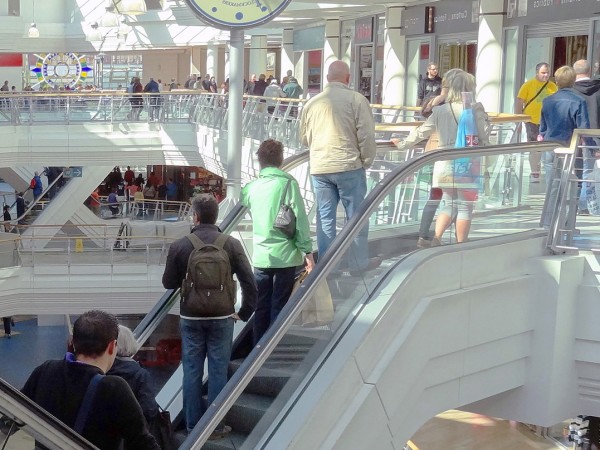 As most developed countries continue to experience relatively low rates of economic growth by historical standards, governments and central banks struggle to find means of stimulating aggregate demand.
As most developed countries continue to experience relatively low rates of economic growth by historical standards, governments and central banks struggle to find means of stimulating aggregate demand.
One explanation of sluggish growth in demand is that people on higher incomes have enough of most things. They have reached ‘peak stuff’. As the Will Hutton article linked below states:
Around the developed world consumers seem to be losing their appetite for more. Even goods for which there once seemed insatiable demand seem to be losing their lustre. Last week, mighty Apple reported that in the last three months of 2015 global sales of the iPhone stagnated, while sales of iPads tumbled from 21m units in 2014 to 16m in the same three months of 2015. In the more prosaic parts of the economy – from cars to home furnishings – there are other warnings that demand is saturated.
People on lower incomes may still want more, but with income inequality growing in most countries, they don’t have the means of buying more. Indeed, a redistribution from rich to poor may be an effective means of increasing aggregate demand and stimulating economic growth.
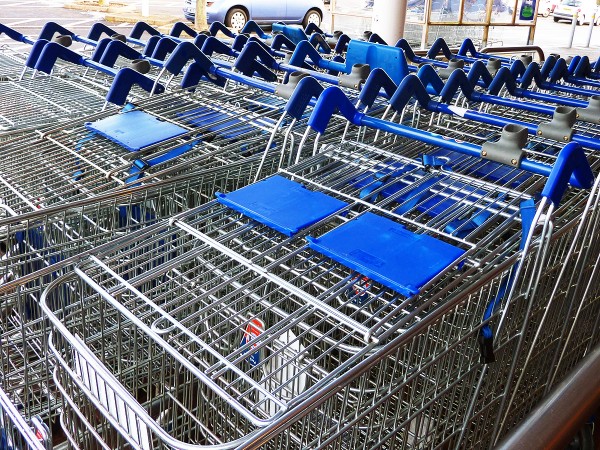 It’s important to clarify what is meant by peak demand for such products. It is not being said that people will stop buying them – that future demand will be zero. People will continue to buy such products. In the case of durables, people will buy replacements when products such as furniture, fridges and cars wear out; or upgraded versions as new models of televisions, smartphones or, again, cars come out; or new music tracks or films as they become available for download, or clothing as new fashions appear in shops. In the case of foodstuffs, concerts, football matches and other consumables, they too will continue to be purchased. The point is, in the case of peak demand, the demand per period of time is not going to grow. And the more products there are that reach peak demand, the harder it will be for companies and economies to grow.
It’s important to clarify what is meant by peak demand for such products. It is not being said that people will stop buying them – that future demand will be zero. People will continue to buy such products. In the case of durables, people will buy replacements when products such as furniture, fridges and cars wear out; or upgraded versions as new models of televisions, smartphones or, again, cars come out; or new music tracks or films as they become available for download, or clothing as new fashions appear in shops. In the case of foodstuffs, concerts, football matches and other consumables, they too will continue to be purchased. The point is, in the case of peak demand, the demand per period of time is not going to grow. And the more products there are that reach peak demand, the harder it will be for companies and economies to grow.
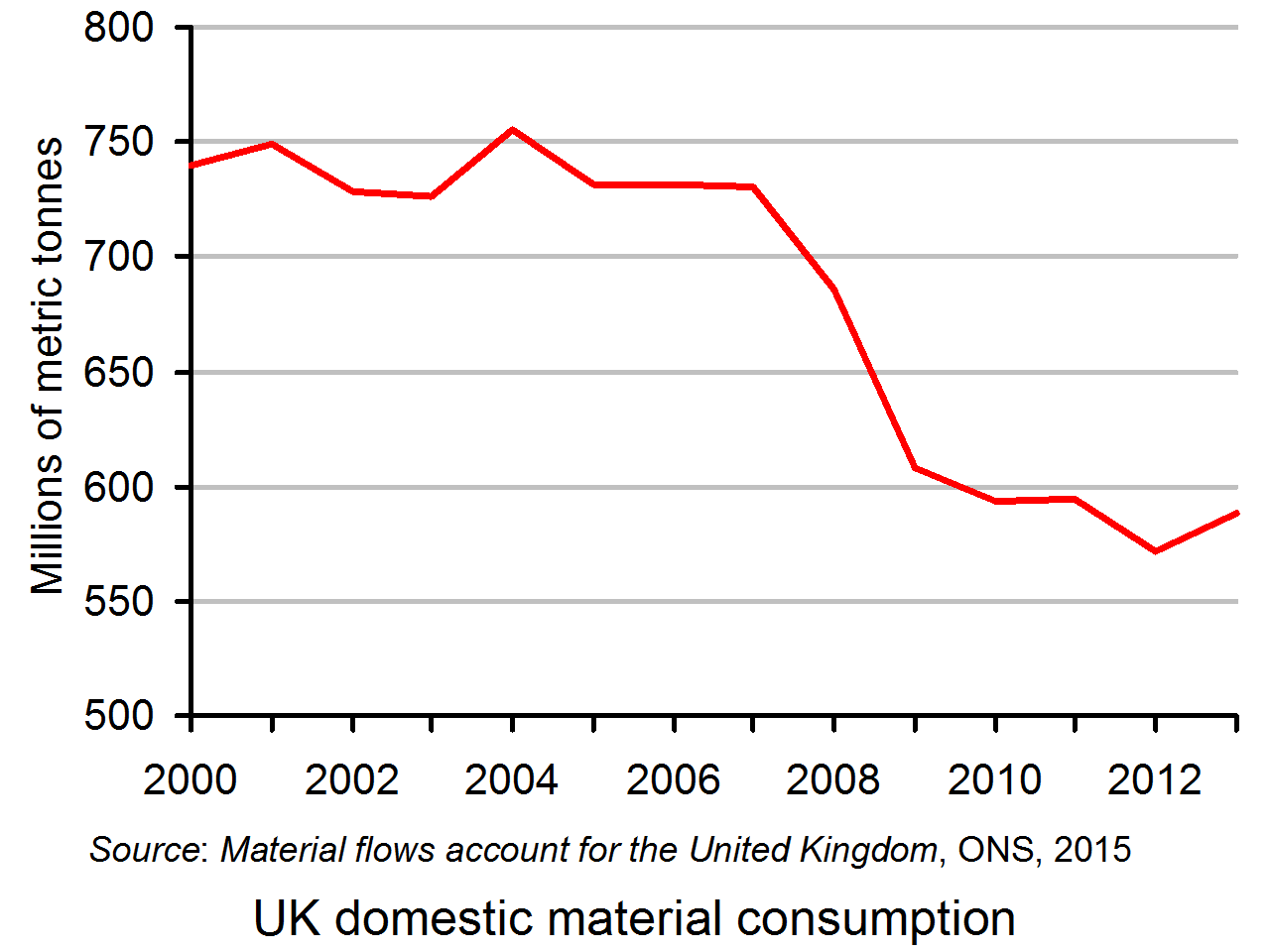 If peak demand has generally been reached, it is likely that the demand for material resources will also have peaked. Indeed, we could expect the demand for material resources to be declining as (a) there has also been an increase in the efficiency of production, so that a lower volume of material inputs is required to produce any given level of output and (b) there has been a general switch towards services and away from physical goods. The graph shows domestic material consumption in the UK in millions of metric tonnes. Domestic material consumption is defined as domestic extraction of resources minus exports of resources plus imports of resources. As you can see, domestic material consumption peaked in 2004.
If peak demand has generally been reached, it is likely that the demand for material resources will also have peaked. Indeed, we could expect the demand for material resources to be declining as (a) there has also been an increase in the efficiency of production, so that a lower volume of material inputs is required to produce any given level of output and (b) there has been a general switch towards services and away from physical goods. The graph shows domestic material consumption in the UK in millions of metric tonnes. Domestic material consumption is defined as domestic extraction of resources minus exports of resources plus imports of resources. As you can see, domestic material consumption peaked in 2004.
But, although peak demand may have been reached in some markets, there are others where there is still the potential for growth. To understand this and identify where such markets may be, it is important to step back from simple notions of consumption to satisfy materialistic demand and focus on the choices people might make to increase their happiness or wellbeing or sense of self worth in society. Thus while we might have reached peak red meat, peak sugar, peak cars, peak furniture and even peak electronic gadgets, we have not reached peak demand for more satisfying experiences. The demand for education, health, social activities, environmental conservation and a range of fulfilling experiences may have considerable potential for growth.
There are business opportunities here, whether in the leisure industry, in building networks of like-minded people or in producing niche goods that satisfy the demands of people with specific interests. But without greater equality there may be many fewer business opportunities in the mass production industries producing standardised goods.
This is not a world in which goods and services are produced at scale as conventionally measured, but a honeycomb economy of niches and information networks whose new dynamics we barely understand, even if we have a better grasp of its values.
Articles
- If having more no longer satisfies us, perhaps we’ve reached ‘peak stuff’
The Guardian, Will Hutton (31/1/16)
- Steve Howard, Ikea Exec, Says The World Has Hit ‘Peak Stuff’
Huffington Post, Zi-Ann Lum (20/1/16)
- We’ve hit peak home furnishings, says Ikea boss
The Guardian, Sean Farrell (18/1/16)
- Peak stuff: the ‘growth’ party is over. So what next?
The Ecologist, Bennet Francis and Rupert Read (22/1/16)
- Have we reached peak ‘stuff’?
The Mancunion, Tristan Parsons (22/2/16)
- Ikea senses room to grow amid ‘peak stuff’
Financial Times, Aliya Ram and Richard Milne (18/1/16)
- Peak Stuff
ifs insights, Janet Hontoir (21/2/16)
- UK retail sales soar as Brits splash their cash on ‘fun stuff’
The Telegraph, Szu Ping Chan (19/2/16)
- How less stuff could make us happier – and fix stagnation
The Guardian, Katie Allen (26/4/16)
Questions
- What are the implications of countries reaching ‘peak stuff’ for (a) the marginal utility of mass produced goods; (b) the marginal propensity to consume and the multiplier?
- Give some examples of goods or services where peak stuff has not been reached.
- If peak stuff has only been reached for certain products, does this mean that there may still be considerable potential for stimulating aggregate demand without a redistribution of income?
- Would it be in the interests of companies such as Asda to make a unilateral decision to pay their workers more? Explain why or why not.
- Why may we be a long way from reaching peak demand for housing, even without a redistribution of income?
- Make out a case for and against tax cuts as a way of stimulating (a) economic growth and (b) a growth in wellbeing? Do your arguments depend on which taxes are cut? Explain.
- The Ecologist article states that “Attaining one-planet living will probably involve in due course achieving degrowth in countries such as ours: building down our economy to a safe level.” Could such an objective be achieved through a mixed market economy? If so, how? If not, why not?
- Does the Telegraph article suggest that peak stuff has not yet been reached as far as most UK consumers are concerned?
 One type of market failing is the asymmetric information between producers and consumers. Advertising, branding and marketing can either help to reduce consumers’ limited information or play on ignorance to mislead consumers.
One type of market failing is the asymmetric information between producers and consumers. Advertising, branding and marketing can either help to reduce consumers’ limited information or play on ignorance to mislead consumers.
Misleading consumers is what the pharmaceutical company Reckitt Benckiser is accused of doing with its Nurofen brand of painkillers. There are very few types of painkiller – the most common three being paracetamol, ibuprofen and aspirin. These are sold cheaply in chemists as unbranded ‘generic products’. Or you can buy much more expensive branded versions of the same drugs. Many people believe that the branded versions are more effective as they are cleverly marketed.
Reckitt Benckiser has been found guilty by the Australian federal court of deceiving consumers. The company produces various varieties of Nurofen, each claiming to target a particular type of pain. But Nurofen Back Pain, Nurofen Period Pain, Nurofen Migraine Pain and Nurofen Tension Headache are in fact identical! And in many outlets, they were sold at different prices – a form of price discrimination reflecting the strength of demand by consumers for a particular type of pain relief.
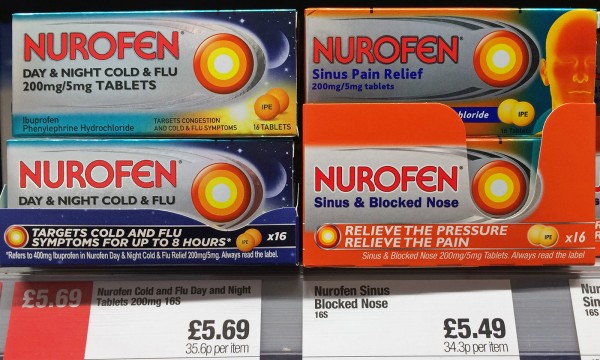 And now the UK Advertising Standards Authority is investigating the company over whether its adverts for Nurofen Express are misleading by stating that the product ‘gives you faster headache relief than standard paracetamol or ibuprofen’. Also it is investigating the company’s claim that its products directly target muscles in the head. Both Nurofen Migraine Pain and Nurofen Tension Headache claim on the front of the box to provide ‘targeted rapid relief’.
And now the UK Advertising Standards Authority is investigating the company over whether its adverts for Nurofen Express are misleading by stating that the product ‘gives you faster headache relief than standard paracetamol or ibuprofen’. Also it is investigating the company’s claim that its products directly target muscles in the head. Both Nurofen Migraine Pain and Nurofen Tension Headache claim on the front of the box to provide ‘targeted rapid relief’.
The company adopts similar practices in its combined pain-killer and decongestant drugs for relieving cold symptoms. For example, its Nurofen Cold and Flu Relief, Nurofen Day and Night Cold and Flu, Nurofen Sinus and Blocked Nose and Nurofen Sinus Pain Relief all contain the same quantities of ibuprofen and the decongestant phenylephrine hydrochloride, but each claims to do something different.
So there are various issues here. The first is whether excessive profits are made by charging a price typically 3 to 4 times greater than the identical generic version of the drug; the second is whether the company deliberately misleads consumers by claiming that a particular version of the drug targets a particular type of pain; the third is whether ‘faster acting’ versions are significantly different; the fourth is whether price discrimination is being practised.
Articles
Nurofen maker Reckitt Benckiser suffers advertising headaches Financial Times, Robert Cookson and Scheherazade Daneshkhu (15/12/15)
Nurofen Express advertising claims probed by UK watchdog BBC News (15/12/15)
ASA probing ‘misleading’ painkiller claims in advert by drug firm behind Nurofen The Telegraph, Tom Morgan and agency (15/12/15)
The great painkiller con: Top drug brands accused of huge mark-ups and misleading claims Mail Online, Sean Poulter and John Naish (16/12/15)
Nurofen Under Investigation By UK Watchdog Over Claims Advert ‘Misled’ Customers Huffington Post, Natasha Hinde (15/12/15)
Australian Competition & Consumer Comission media release
Court finds Nurofen made misleading Specific Pain claims ACCC (14/12/15)
Questions
- Is price discrimination always against the consumer’s interests?
- What form of price discrimination is being practised in the case of Nurofen?
- How, do you think, does Reckitt Benckiser decide the prices it charges retailers for its pain killers and how, do you think, do retailers determine the price they charge consumers for them?
- Is it a reasonable assumption that branded products in most cases are better than own-brand or generic versions? How is behavioural theory relevant here?
- If Reckitt Benckiser were banned from using the word ‘targets’ when referring to one of its product’s effect on particular type of pain, could the company instead use the words ‘suitable for’ relieving a particular type of pain and thereby avoid misleading consumers?
- What is the best way of improving consumer knowledge about particular types of over-the-counter drugs and their effects on the body?
- Comment on the following statement by Dr Aomesh Bhatt, the company’s medical affairs director: ‘The Nurofen specific-pain range was launched with an intention to help consumers navigate their pain relief options, particularly within the grocery environment where there is no healthcare professional to assist decision making.’
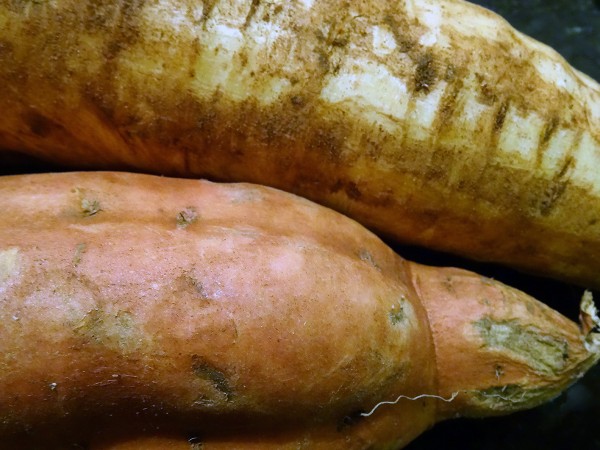 This rather strange question has been central to a storm that has been brewing between various celebrity chefs, including Jamie Oliver and Hugh Fearnley-Whittingstall, and the supermarkets. Supermarkets say that consumers don’t want irregular shaped vegetables, such as carrots, parsnips and potatoes. ‘Nonsense’, say their critics.
This rather strange question has been central to a storm that has been brewing between various celebrity chefs, including Jamie Oliver and Hugh Fearnley-Whittingstall, and the supermarkets. Supermarkets say that consumers don’t want irregular shaped vegetables, such as carrots, parsnips and potatoes. ‘Nonsense’, say their critics.
At the centre of the storm are the farmers, who find a large proportion of their vegetables are rejected by the supermarkets. And these are vegetables which are not damaged or bad – simply not of the required shape. Although these rejected vegetables have been described as ‘wonky’, in fact many are not wonky at all, but simply a little too large or too small, or too short or too long. Most of these vegetables are simply wasted – ploughed back into the ground, or at best used for animal feed.
And it’s not just shape; it’s colour too. Many producers of apples find a large proportion being rejected because they are too red or not red enough.
 But do consumers really want standardised fruit vegetables? Are the supermarkets correct? Are they responding to demand? Or are they attempting to manipulate demand?
But do consumers really want standardised fruit vegetables? Are the supermarkets correct? Are they responding to demand? Or are they attempting to manipulate demand?
Supermarkets claim that they are just responding to what consumers want. Their critics say that they are setting ludicrously rigid cosmetic standards which are of little concern to consumers. As Hugh Fearnley-Whittingstall states:
‘It’s only when you see the process of selection on the farm, how it has been honed and intensified, it just looks mad. There are many factory line systems where you have people looking for faults on the production line; in this system you’re looking for the good ones.
What we’re asking supermarkets to do is to relax their cosmetic standards for the vegetables that all get bagged up and sold together. It’s about slipping a few more of the not-so-perfect ones into the bag.’
In return, consumers must be prepared to let the supermarkets know that they are against these cosmetic standards and are perfectly happy to buy slightly more irregular fruit and vegetables. Indeed, this is beginning to happen through social media.  The pressure group 38 degrees has already taken up the cause.
The pressure group 38 degrees has already taken up the cause.
But perhaps consumers ‘voting with their feet’ is what will change supermarkets’ behaviour. With the rise of small independent greengrocers, many from Eastern Europe, there is now intense competition in the fruit and vegetables market in many towns and cities. Perhaps supermarkets will be forced to sell slightly less cosmetically ‘perfect’ produce at a lower price to meet this competition.
Videos
 Hugh’s War on Waste Episode 1 BBC on YouTube, Hugh Fearnley-Whittingstall (2/11/15)
Hugh’s War on Waste Episode 1 BBC on YouTube, Hugh Fearnley-Whittingstall (2/11/15)
 Hugh’s War on Waste Episode 2 BBC on YouTube, Hugh Fearnley-Whittingstall (9/11/15)
Hugh’s War on Waste Episode 2 BBC on YouTube, Hugh Fearnley-Whittingstall (9/11/15)
Articles
Hugh Fearnley-Whittingstall rejects Morrisons’ ‘pathetic’ wonky veg trial The Guardian, Adam Vaughan (9/11/15)
Jamie Oliver leads drive to buy misshapen fruit and vegetables The Guardian, Rebecca Smithers (1/1/15)
Hugh Fearnley-Whittingstall’s war over wonky parsnips The Telegraph, Patrick Foster (30/10/15)
Asda extends ‘wonky’ fruit and veg range Resource, Edward Perchard (4/11/15)
Wearne’s last farmer shares memories and laments loss of farming community in Langport area Western Gazette, WGD Mumby (8/11/15)
Viewpoint: The rejected vegetables that aren’t even wonky BBC News Magazine (28/10/15)
Viewpoint: The supermarkets’ guilty secret about unsold food BBC News Magazine (6/11/15)
Questions
- What market failures are there is the market for fresh fruit and vegetables?
- Supermarkets are oligopsonists in the wholesale market for fruit and vegetables. What is the implication of this for (a) farmers; (b) consumers?
- Is there anything that (a) consumers and (b) the government can do to stop the waste of fruit and vegetables grown for supermarkets?
- How might supermarkets estimate the demand for fresh fruit and vegetables and its price elasticity?
- What can supermarkets do with unsold food? What incentives are there for supermarkets not to throw it away but to make good use of it?
- Could appropriate marketing persuade people to be less concerned about the appearance of fruit and vegetables? What form might this marketing take?
 The 2015 Rugby World Cup is now well under-way, with record crowds, surprising results and some heartbreak. But what about the economic impact of the Rugby World Cup? Big sporting events bring in spectators (estimated to be 466,000), athletes and crucially they all spend money. But what happens when the host country doesn’t make it through? Unfortunately for all England fans out there, this is a very relevant question.
The 2015 Rugby World Cup is now well under-way, with record crowds, surprising results and some heartbreak. But what about the economic impact of the Rugby World Cup? Big sporting events bring in spectators (estimated to be 466,000), athletes and crucially they all spend money. But what happens when the host country doesn’t make it through? Unfortunately for all England fans out there, this is a very relevant question.
Go to the area surrounding a stadium on the day of a rugby world cup match and you will barely find a pub with any room to move. Spending on drinks and food in local pubs and restaurants on match days is extremely high and many hotels are at breaking point with reservations. Predictions were that there would be an increase in direct expenditure by international visitors of £869 million. A report by Ernst and Young looked at the Economic Impact of the Rugby World Cup 2015 and it provides detailed analysis of how such sporting events can generate benefits to the host nation. The highlights are:
- £2.2 billion of output into the economy
- £982 million of value added to national GDP
- £85 million in infrastructure
- 41,000 jobs across the country
- £1 billion of added value
But, what happens when you take out the host team? Suddenly we see less interest in the daily matches and the feel good spirit takes a dive. Of course, the other home teams are still around and English fans are being encouraged to support them, but commentators suggested that this early exit will have a significant economic impact. Alex Edmans from the London Business School suggests that when a host nation exits a rugby sporting event at an early stage, the pessimism can wipe 0.15% of the stock market the following day. This translates to around £3 billion for the UK. He noted:
A defeat makes investors more negative about life in general. If England were to lose, they wouldn’t just be negative about the England rugby team but also about economic outcomes in general.
Advertising revenues may also be hit, with a significant impact on ITV, who are showing all matches. With England out, the value of advertising slots has fallen and the advertising impact on some of the key England sponsors, such as O2, may be significant. However, English ticket holders may use this as an opportunity to make money, selling on their tickets to fans of surviving teams! The following articles and report from Ernst and Young consider this latest major sporting event that has come to the UK.
Articles
The Economic Impact of Rugby World Cup 2015 Ernst and Young 2014
An England Rugby World Cup exit could have knock-on effect for our stock market The Guardian, Sean Farrell (1/10/15)
Brands cheer on Rugby World Cup in face of England’s exit Financial Times, Malcolm Moore (4/10/15)
Rugby World Cup 2015: Early England exit could cost country £3bn International Business Times, Alfred Joyner (6/10/15)
Rugby World Cup brands play down commercial losses of England’s ‘lacklustre’ exit The Drum, Seb Joseph (5/10/15)
Questions
- What is an Economic Impact Analysis?
- How would you estimate the size of the multiplier effect of a sporting event, such as the Rugby World Cup?
- Following England’s exit, what happened to the stock market?
- How will media companies be affected by the Rugby World Cup and by England’s exit?
- Why do emotions affect the stock market?
- Do you think England’s exit will lead to greater spending in other parts of the country, such as Scotland and Wales, as England fans defect?
 Behavioural economists study how people’s buying, selling and other behaviour responds to various incentives and social situations. They don’t accept the simplistic notion that people are always rational maximisers. As the Livemint article below states, “According to behavioural economists, the human brain neither has the time nor the ability to process all the information involved in decision making, as assumed by the rational model.” Instead, rationality is bounded: people use simple rules of thumb in making decisions – rules they have developed over time in the light of experience.
Behavioural economists study how people’s buying, selling and other behaviour responds to various incentives and social situations. They don’t accept the simplistic notion that people are always rational maximisers. As the Livemint article below states, “According to behavioural economists, the human brain neither has the time nor the ability to process all the information involved in decision making, as assumed by the rational model.” Instead, rationality is bounded: people use simple rules of thumb in making decisions – rules they have developed over time in the light of experience. The text messages getting teenagers better grades BBC Today Programme, David Halpern and Fiona Morey (15/9/16)
The text messages getting teenagers better grades BBC Today Programme, David Halpern and Fiona Morey (15/9/16)








